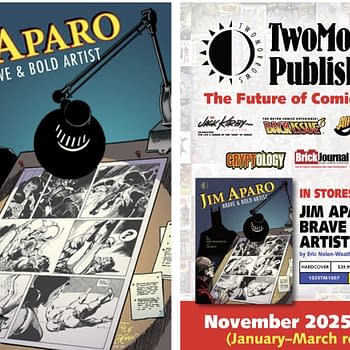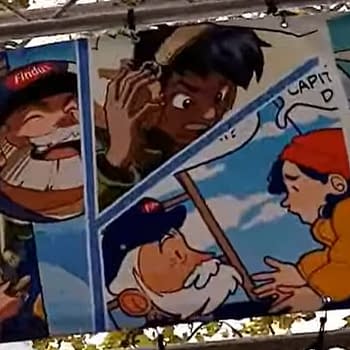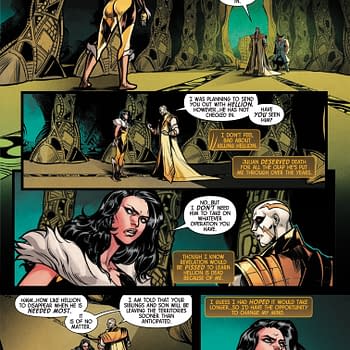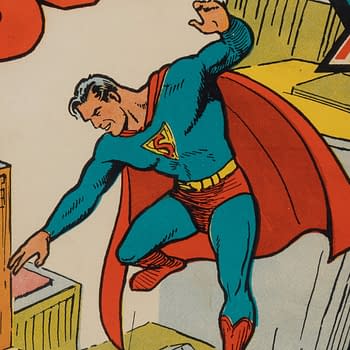Posted in: Comics | Tagged: amazing fantasy, Comics, detective comics 27, library of congress, spx, stan lee, steve ditko, zap 0
Holding Steve Ditko's Original Art To Amazing Fantasy #15 In My Hands – The Library of Congress' EPIC Comics Collection
By David Dissanayake
In retrospect, it should have been obvious that the Library of Congress would have one of the greatest comics collections in the world, but for some reason I never thought "comics" when I thought of the U.S.' national library. Well, it turns out it has a collection of more than 11,000 titles with over 130,000 single issues, not including double copies or the multiple thousands of comics that are still in line to be catalogued, nor does it include the thousands of graphic novels and collected editions stored in a separate division than the single issue comics. Also, it's a collection that grows by roughly 2,500 new comics a year.
And here I thought my collection was starting to look extensive.
I went in to the Library of Congress in Washington, DC to talk with the absolutely amazing women who are in charge of collection. I want to give a big shout out and send my biggest thanks and utmost respect to the Mighty, Amazing, Fantastic, Incredible, Uncanny women who work tirelessly to keep this massive collection in order: Donna Urschel, Georgia Higley, Megan Halsband, Martha Kennedy, and Sara Duke, who were kind enough to take an afternoon showing me around the absolutely jaw-dropping collection of comics, graphic novels, prints, and original art that far too few people know about.
The Library's collection is so vast it needs three separate departments to house all of it: the Newspapers and Periodicals division (which houses the individual, serialized comics), Prints and Photographs (that contains all of the prints and original artwork) and the General Collection, (which houses the graphic novels and collected editions).
"Unfortunately, I think the comic book collection is one of the best kept secrets here." Said Georgia, head of the Newspapers and Periodicals section of the library and Curator of the comics collection. "When you think of the Library of Congress do you think of comic books?"
Georgia and Megan both serve as Recommending Officers for the collection which is shaped by the Library's larger overarching collection policy for the departments. Designed to fill perceived gaps in the collection's subject matter, the current collection agenda includes, mini comics, nontraditional comics formats, Ignatz nominees, comics by and about women, comics about health and human sexuality, and comics by and about minorities. It's really heartening to hear that the Library is going out of its way to find this kind of content to be stored for the ages.
"We're trying to figure out what people 50 years in the future will be interested in," said Georgia. "That's always on your mind when thinking about these things. Now I've been erring on the side of collecting more titles. We can always take things away, but as they say in newspaper, there's nothing harder to get than yesterday's news, and you can say the same thing about comics. It's expensive trying to get yesterday's comics, and we've spent a fortune."
Indeed, the collection had to spend what I imagine to be a considerable chunk of its departmental acquisitions budget to buy copies of Detective Comics #1, Amazing Fantasy #15, Superman #1, among other exceedingly rare and expensive comics of ages past
As for current comics, the library has been trying to increase its collection of independent and mini comics by beginning a partnership with the Small Press Expo. SPX donates copies of all Ignatz Awards nominees of that particular year to the Library's collection and in return, SPX now has its own official collection at the Library. Georgia, Megan, Sara, and Martha have been going to SPX every year since the partnership began to find new items for the collection, with the help and input of the great Warren Bernard, Executive Director of SPX.
"The great thing about the SPX collection is that much of it is experimental," said Georgia. "You may not have the person that's the most famous small press creator doing these kinds of things, but you will have someone who may be at the start of their career, and we're capturing that. Many people at the beginning of their career are a lot more nimble in terms of creatively trying things out than people who are established. When we started working with SPX on this collection it was a real opportunity to see and collect that range of imagination."
Megan agreed, adding that "there are so many things out there you wouldn't know about unless you're out on the floor taking a look at what people brought with them every year. That's one of the cool things that's happened over the last three years that we've been going to SPX, is that people have started recognizing us and we've been able to establish relationships with the creators and get to know them and their work."
The past two years saw indie comics luminaries Dean Haspiel and Heidi MacDonald both donating their entire mini comics collection to the library. To commemorate the gifts, both creators gave lectures at the Library the day before SPX 2012 and 2013 respectively. The library wants to make a tradition out of having an independent comics luminaries come and talk every year on the Friday before SPX, coupled with a display of items from the SPX collection.
Now, outside of the indie comics scene, the collection is home to some of the most valuable comics out there, including Detective Comics #1, Superman #1, Amazing Fantasy #1, Archie #1, Zap Comics #0, and countless others (though unfortunately, Action Comics is one that's missing from the collection). There are countless full runs of series housed (among other things) in a gigantic football field sized warehouse in one of the Library's multiple buildings here in Washington, DC. Most of the valuable books are categorized by their rarity at a "Gold" level which warrants their being housed in a giant vault with other national treasures.
It's very rare that the Library stops collecting a particular title, but it turns out that Blue Beetle was a title that was actually dropped from the continuous collection list.
Unfortunately the Library is not a browsing library, even though they wish they could be. That means that people can't come in, pick up a stack of comics, read through them and then put them back. It's an unfortunate truth that the nature of the often times cheap material used to make comic books makes them a very easily damaged medium that is hard to preserve over time, and the Library has to take extra care to keep them around for future generations.
"One of the things we try and figure out is how we can get the collection processed so that not only do people know what we have but also to make sure we are preserving them in a way that allows people in the future to look at them as well," explained Georgia. "It is challenging for us because we want people to know about the collection and come and use it, but it is a research collection and we can't pull out whatever they want any time they want it, unfortunately," added Meghan. "In some respects we're fighting an uphill battle to promote the collection, because it is something that once people figure out that we have, there are some amazing things that people can do with it."
The Library of Congress is, after all, a research library. In fact there has been a growing interest in the comics collection with dozens of researchers coming to Washington in order to utilize the collection for a wide variety of research topics. For people doing any kind of historical, socio-cultural research, this collection is a veritable gold mine. Georgia noted she has seen that "social history is a large developing research area, and people are starting to tap into popular culture, and people are really starting to use these [comics] in tandem with what some people consider the more 'serious' research tools to make some new, valuable connections."
Unfortunately, the majority of the collection is not digitized, and there is still a backlog of thousands of un-catalogued comics that the librarians are waiting to get through. "Both Georgia and I would happily work on the comics collection, if given free rein to exclude our other duties," says Meghan laughing, "but unfortunately we can't, as much as we might want to."
Now, the Library's collection of original comic art is just as staggering as their comics collection. Art from some of the best cartoonists now rest in the Library's care, including a 36,000 collection of original Art Wood cartoons, over 14,000 finished Herb Block cartoons (not including the hundreds of additional sketches, scripts, and manuscripts), not to mention original Sal Bescema Captain America pages, John Severin's Hulk, a complete seven page Will Eisner story, and get this, the complete original art from the entire issue of Amazing Fantasy #15, the first ever appearance of Spider Man by Steve Ditko and Stan Lee.
I had never read Amazing Fantasy #15 before, and I was allowed to read it for my very first time via Steve Ditko's original hand-drawn pages. It was amazing.
Knowing that there is an institution collecting and preserving comics for future generations puts my mind at ease. Comics are so ephemeral, so vulnerable to wear and tear, yet they are packed with so many important aspects about the times from which they came. They store so much cultural information about our past, present and even future that, though we might be completely ignorant of what gems of understanding they hold in the here and now, they will be incredibly important for future generations who will be able to look back and learn things about us in the same way we in the here and now look back at past ages of comics to learn about those times. Preserving comics is such an important undertaking, not only for comics as a medium, but for our culture and for history itself. And for that, I want to again give my greatest thanks, appreciation, and respect to Donna, Georgia, Megan, Sara, and Martha for helping to preserve our comics, our culture, and our history.






















